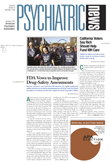Could youngsters' behavior while eating lunch predict which ones will develop schizophrenia? It sounds rather improbable, but perhaps, a study reported in the November American Journal of Psychiatry suggests. The study was headed by Jason Schiffman, Ph.D., an assistant professor of psychology at the University of Hawaii at Manoa.
Some 9,000 children were born in a particular hospital in Copenhagen, Denmark, between 1959 and 1961. In 1972, when the children were between 11 and 13 years of age, some 250 were selected for an investigation into the early signs of schizophrenia. A number of these adolescents had a parent with schizophrenia and thus were at high risk for developing the illness.
One aspect of the study consisted of videotaping the youngsters while eating lunch to record their social behavior and neuromotor skills. Lunch consisted of Danish open-face sandwiches constructed in layers and requiring some motor skills to consume.
These adolescents were followed up in 1992, when they were between the ages of 31 and 33, to determine whether any of them had been diagnosed with schizophrenia or other psychiatric disorders.
Now Schiffman and his colleagues have used videotaped lunch behaviors from some 150 of the adolescents to determine whether the social behavior and neuromotor functioning of those who later developed schizophrenia differed from those who later had no mental illness or another mental disorder.
The researchers found that the adolescents who later developed schizophrenia had, on average, a lower total score on a sociability scale including smiles, laughs, and vocalizations than did adolescents who developed other kinds of psychopathology or remained free of mental disorder. Boys who later developed schizophrenia scored, on average, higher on a neuromotor scale consisting of involuntary facial movements, raised elbows, nystagmus-like eye movements, and other abnormal movements than did boys who developed other psychopathology or none.
In an accompanying editorial, Gabrielle Carlson, M.D., a child-adolescent psychiatrist and professor of psychiatric and pediatrics at the State University of New York at Stony Brook, wrote: “Prospective follow-up studies are treasures.... That a videotape of a casual interaction can detect children at risk for schizophrenia because they smile, laugh, and initiate conversation less often than nonaffected peers is amazing....”
Fewer grins and chuckles and less chitchat, of course, are no guarantee that youngsters will develop schizophrenia. They may have a naturally reticent nature or perhaps suffer from another mental condition such as social anxiety.“ Depression and pervasive developmental disorder can also dampen expressions of happiness and volubility in youth,” Carlson told Psychiatric News.
So what is needed at this juncture, she said, is further research to examine the sensitivity and specificity of these findings and whether they might be used in conjunction with teacher ratings and parent ratings to identify youth at high risk of schizophrenia. However, “I am not aware of any studies of this nature being done,” she said.
Schiffman and his coworkers are conducting another study that should further reveal whether adolescent lunch behaviors might predict schizophrenia. The project, he explained to Psychiatric News, “is a more in-depth analysis of the youth from the current study combining various neurological measures of functioning to increase the predictive ability to detect schizophrenia. In addition to the videotaping conducted for this report, various other indices of neurological functioning were gathered. We anticipate that by combining these predictors, we might not only learn more about the neurodevelopmental basis of schizophrenia, but also gain clinically predictive utility among youth at genetic risk for schizophrenia.”
The study was funded by the National Institute of Mental Health.
Am J Psychiatry 2004 161 2021
